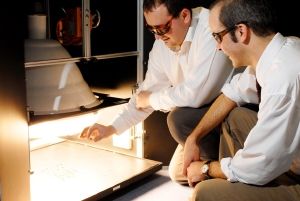Mar 6 2008
Researchers at Swansea University are developing a new, eco-friendly technology that could generate as much electricity as 50 wind farms.
 Dr Dave Worsley (right) and Dr Trystan Watson of the Materials Research Centre at Swansea University, investigating the efficiency of new solar cells under a Dyesol Solar Simulator.
Dr Dave Worsley (right) and Dr Trystan Watson of the Materials Research Centre at Swansea University, investigating the efficiency of new solar cells under a Dyesol Solar Simulator.
Dr Dave Worsley, a Reader in the Materials Research Centre at the University's School of Engineering, is investigating ways of painting solar cells onto the flexible steel surfaces commonly used for cladding buildings.
"We have been collaborating with the steel industry for decades," explains Dr Worsely, "but have tended to focus our attention on improving the long-term durability and corrosion-resistance of the steel. We haven't really paid much attention to how we can make the outside of the steel capable of doing something other than looking good.
"One of our Engineering Doctorate students was researching how sunlight interacts with paint and degrades it, which led to us developing a new photovoltaic method of capturing solar energy."
Unlike conventional solar cells, the materials being developed at Swansea are more efficient at capturing low light radiation, meaning that they are better suited to the British climate.
A research grant from the Welsh Assembly Government's Welsh Energy Research Centre (WERC) enabled Dr Worsley to work with leading metals group Corus to investigate the feasibility of developing an efficient solar cell system that can be applied to steel building products.
The success of the study led to the award of a three-year project worth over £1.5 million by the Engineering and Physical Sciences Research Council (EPSRC).
Swansea University is now leading a partnership with Bangor University, University of Bath, and the Imperial College London to develop commercially viable photovoltaic materials for use within the steel industry.
Paint is applied to steel when it is passed through rollers during the manufacturing process, and it is hoped that the same approach can be used to build up layers of the solar cell system. The researchers' aim is to produce cells that can be painted onto a flexible steel surface at a rate of 30-40m2 a minute.
Dr Worsley believes that the potential for the product is immense.
He said: "Corus Colours produces around 100 million square metres of steel building cladding a year. If this was treated with the photovoltaic material, and assuming a conservative 5% energy conversion rate, then we could be looking at generating 4,500 gigawatts of electricity through the solar cells annually. That's the equivalent output of roughly 50 wind farms."
Dr Worsley will be working closely with Corus to research practical, cost-efficient methods of mounting the system on steel structures, with a view to the eventual commercialisation of the product.
He said: "This project is a superb example of the value of collaboration between universities and industry, and it is definitely important for Wales. We have a genuine opportunity to ensure that Wales remains at the forefront of this technology worldwide, driving the industry and revolutionising our capacity to generate electricity.
"I think it shows great vision from the Welsh Assembly Government that they funded the initial feasibility study. Even if we are only mildly successful with this project, there is no doubt that we will be creating an exciting hi-tech steel product that will preserve the long term future of the Welsh steel industry."